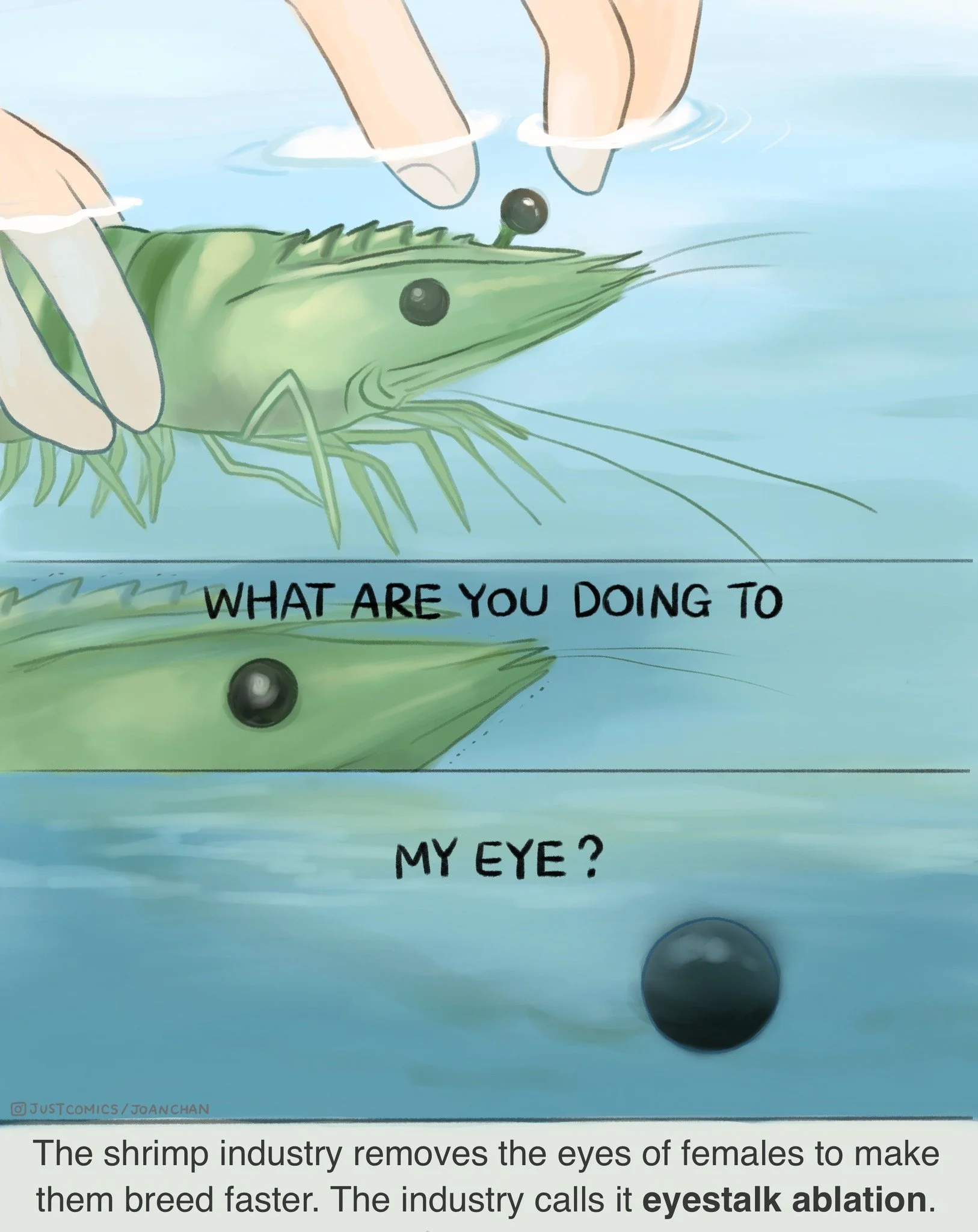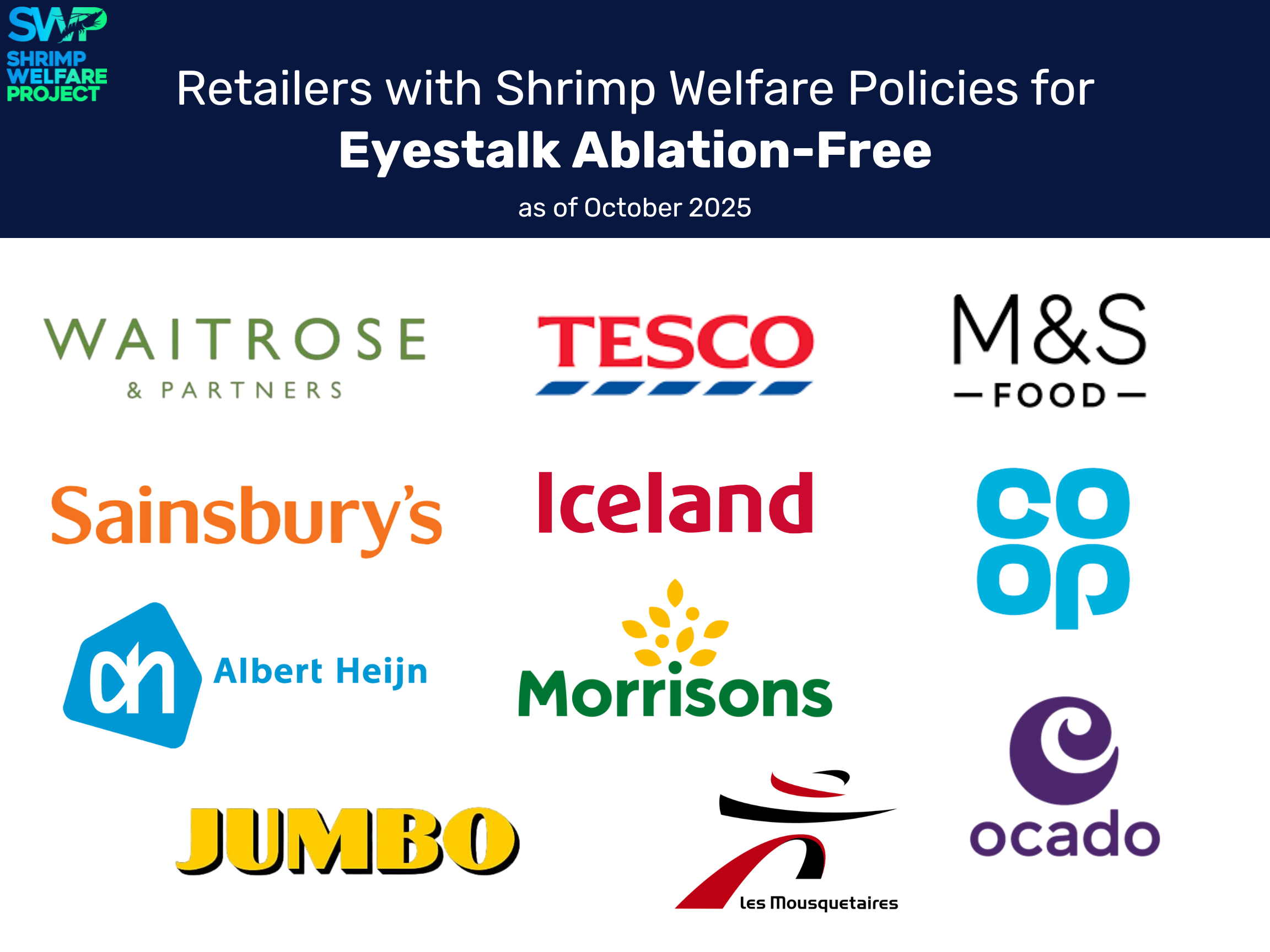What is eyestalk ablation?
Eyestalk ablation is the practice of removing one or both of a mother shrimp’s eyes by crushing, cutting, burning, or tying it off in order to speed up maturation and increase spawning. But it comes at a significant cost to shrimps’ health and welfare.
Why do farmers cut off mother shrimps’ eyes?
In captivity, many shrimp species don’t reproduce as readily as they might in the wild. Farmers have found that eyestalk ablation can increase egg production in hatcheries.
Why? Crustaceans, like shrimps, have a structure in their eyestalks called the X-organ-sinus-gland complex, which produces and stores hormones, such as:
The Gonad-Inhibiting Hormone controls shrimps’ reproductive organs, when they mature, and when spawning happens.
Removing the gland speeds up shrimps’ maturation and makes them spawn sooner.
The Moult-Inhibiting Hormone affects shrimps’ process of shedding their exoskeleton (outer shell) and growing a new one.
Moulting usually occurs naturally and is an important part of a shrimps’ life cycle, but it uses a lot of the animal’s energy – meaning they have less energy to use for reproduction.
They become exhausted and stressed, and since shrimps who have recently moulted have softer bodies, this can be a vulnerable time for them.
Other shrimps eat them because they can’t defend themselves without a hard shell.
Other important hormones are not released properly, which leads to hormonal problems. This causes lower survival rates of mother shrimps, reduced quantity and quality of offspring, physical harm, health issues, reproductive exhaustion, weight loss, and stress.
Artist Just Comics’ illustration of eyestalk ablation recently went viral on social media.
Does removing shrimps’ eyes make them breed faster?
While it has long been believed that removing shrimps’ eyestalks leads to greater mating success and more frequent spawning, this practice comes with significant long-term costs. Research shows that ablated shrimp suffer nearly double the mortality rate and experience lower reproductive output over their lifespan.
Offspring from non-ablated mothers also tend to fare better, showing higher survival rates when exposed to common aquaculture diseases.
Evidence suggests that many other factors influence productivity, including environmental conditions during spawning, fertilization rates, and overall animal health. By adjusting husbandry practices, farmers can offset any reduction in mating rates from non-ablated shrimp and support more sustainable breeding.
Does eyestalk ablation hurt shrimps?
Eyestalk ablation causes pain and distress, as evidenced by shrimps flicking their tails and rubbing their eye areas afterwards.
For mother shrimps, it leads to shorter lifespans, hormonal imbalances, and lower reproductive productivity long-term.
Ablated shrimps’ offspring are lower quality, as they’re less tolerant of stress and more likely to get diseases.
These health issues can affect production, ultimately leading to less financial profits for farmers.
How can I help mother shrimps?
At Shrimp Welfare Project, we advocate for higher welfare practices in the shrimp farming industry and encourage consumers to demand the same from their local supermarkets.
Major grocery chains have committed to keep their supply chains free of eyestalk ablation:
Tesco (UK)
Marks & Spencer (UK)
John Lewis Partnership/Waitrose (UK)
Ocado (UK)
Sainsbury’s (UK)
Co-op (UK)
Morrisons (UK)
Iceland (UK)
Albert Heijn (Netherlands)
Jumbo (Netherlands)
Les Mousquetaires (France)
Shrimp Welfare Project celebrates producers, suppliers, and retailers who have committed to using non-ablated broodstock in their supply chains. We raise awareness and promote more humane practices in the shrimp industry, shining a spotlight on companies who are leading the way in responsible and ethical aquaculture. Learn more about our Eyestalk Ablation-Free programme.


